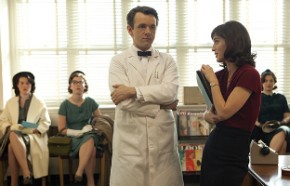Sex in the lab

“We are scientists, after all,” says Virginia Johnson (Lizzy Caplan) as she removes her blouse and bra and places Bill Masters’s (Michael Sheen) hand on her breast. The Showtime series Masters of Sex follows the sex researchers from the late 1950s through the early 1960s. In an early episode the couple begins to sleep together for the purposes of science.
This might sound like a handy excuse for an affair, but that’s only part of the story. Sex, Bill argues, is a taboo subject in science because of moral and religious interpretations. By explaining what happens to the human body during sex he hopes to lift the shroud and receive a Noble Prize for his achievements. (He proves his point about the taboo of sex and demonstrates the size of his ego when he shows his colleagues a video of a woman masturbating.) For Virginia this study is the first time she’s been taken seriously as a woman of ideas. And as someone who’s been divorced twice and is frequently in casual relationships, she has her own reason for fighting sexual taboos.
Both researchers are motivated by their scientific investigation and believe that sleeping together is part of their work. But their motivations are of course more complicated: it’s after having sexual fantasies about Virginia that Bill proposes that they “undertake the work,” while Virginia initiates the sexual encounter immediately after Bill promotes her. Science, power, attraction, and control become entangled as they go to bed.





